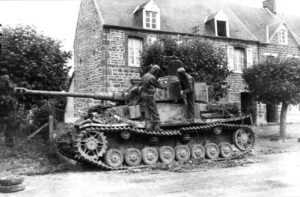Saint-Denis-le-Gast (Manche)
The cities of Normandy during the 1944 battles
Two American tankers inspect a German SdKfz 161 Panzerkampfwagen IV tank, numbered 831, which was disabled in Saint-Denis-le-Gast by men of the 41st Infantry Regiment on July 29, 1944. One of the soldiers points to the entry point of the shell that penetrated the turret, at the location of the number « 1. »
Photo: US National Archives
- Liberation: 30 July 1944
- Deployed units:
![]() 41st Infantry Regiment, Combat Command B, 2nd Armored Division
41st Infantry Regiment, Combat Command B, 2nd Armored Division
![]() 41st Infantry Regiment, Combat Command B, 2nd Armored Division
41st Infantry Regiment, Combat Command B, 2nd Armored Division
![]() 702nd Tank Destroyer Battalion
702nd Tank Destroyer Battalion
![]() Panzer-Lehr-Division
Panzer-Lehr-Division
- History :
On July 20, during preparations for Operation Cobra, the 2nd Armored Division was tasked, through Operational Action Order 4, with capturing Saint-Denis-le-Gast after overcoming a series of objectives.
On July 28, just two days after the start of its engagement, the American armored division achieved an impressive breakthrough, bypassing from the east part of the German Panzer Lehr Division, trapped in the « Roncey Pocket. » Around 3:00 PM, the leading elements of Combat Command B (CCB) were ordered to set up roadblocks on the axis between Saint-Denis-le-Gast and Lengronne: the goal was to cut off any possibility of German escape southward.
On the morning of July 29, the first reconnaissance elements belonging to the 41st Infantry Regiment approached Saint-Denis-le-Gast from the west. The village was still occupied by the Germans: an American half-track, equipped with a 37 mm cannon, immediately moved into position. Aboard the half-track, the sergeant designated the objectives: the crew quickly neutralized a German anti-tank gun as well as a Panzer IV tank, identified as « 831 » (8th company), having pierced the turret armor and killed the commander. A few minutes later, the first armored vehicles of Squadron A of the 67th Armored Regiment reached Saint-Denis-le-Gast and prepared to engage in combat, alerted by the fire of the anti-tank gun. Lieutenant Clifton Roe’s M4 Sherman tank opened fire in the dangerous direction, but one of its shells fell short: it struck the American sergeant aboard his half-track, killing him instantly.
This tragedy was not the only one to unfold in Saint-Denis-le-Gast on the afternoon of July 29. During the reconnaissance of the village, near the disabled Panzer IV, tensions were particularly high in the American ranks. Observing movement from an upstairs window of a house, Private Gilbert V. White opened fire with his personal weapon, thinking it was a German sniper. Unfortunately, it was Mrs. Alexandre Guenier, 61, hit by several shards of glass. She ultimately died of her wounds a few moments later.
To secure the line between Saint-Denis-le-Gast and Lengronne, Squadron A retained one of its platoons in Saint-Denis, reinforced by a TD M-10 tank destroyer from the 702nd Tank Destroyer Battalion and infantrymen from Company B of the 41st Infantry Regiment. They were tasked with preventing any German retreat from the Roncey pocket: their sector was put on alert in the last hours of daylight, as the sound of tanks coming from the north was heard. Positioned on the outer edges of the town, the Americans established a defensive perimeter around the fields and orchards, forming a trap into which they were able to open fire on any enemy who rushed through.
When darkness fell completely, a German column took a chance and took the road connecting Saint-Denis-le-Gast to Saint-Martin-de-Cenilly. At two o’clock in the morning on July 30, the crew of an M5 tank from Squadron A, commanded by Sergeant Charles Douglas Tanner, was stationed in Saint-Denis facing north when it detected the lead vehicle of the opposing column: a German self-propelled gun. Opening fire with its 37 mm cannon, it was immediately attacked by the column, notably by Panzerfausts fired by the dismounted infantrymen. A major close-quarters battle began immediately, sowing panic in the American ranks: flares were fired, causing moving shadows to appear in and around the village. The Germans opened fire with all their weapons, forcing the American fighters at best to lower their heads as they passed, at worst to abandon their positions. The soldiers of Company B finally retreated outside the village, in complete disorder. A handful of them resisted, holding firm against the barrage of steel raining down on them.
Around 3:15 a.m., Sergeant Tanner’s vehicle was hit for the second time, a shell hitting the turret and seriously wounding him. His driver, John Kapanowski, pulled him from the burning armored vehicle, but he was unable to save Tanner, who died near his tank. The Germans took advantage of this to retake the village and secure the route to evacuate as many of their troops as possible. At least five armored vehicles, two half-track vehicles, and more than a hundred German infantrymen managed to cross Saint-Denis-le-Gast during the night.
At daybreak, the American infantrymen cautiously entered the town, supported by a Tank Destroyer, fearing that their enemy was still defending Saint-Denis. But the Germans abandoned the village and slipped out under cover of darkness. The 2nd Armored Division took advantage of the situation to re-establish itself and resupply its units before the next operations.
Sergeant Tanner was posthumously awarded the Silver Star and the Croix de Guerre for his heroic resistance in Saint-Denis-le-Gast in the early hours of July 30, 1944.
Saint-Denis-le-Gast map:
![]() Back to the Normandy cities in 1944
Back to the Normandy cities in 1944

